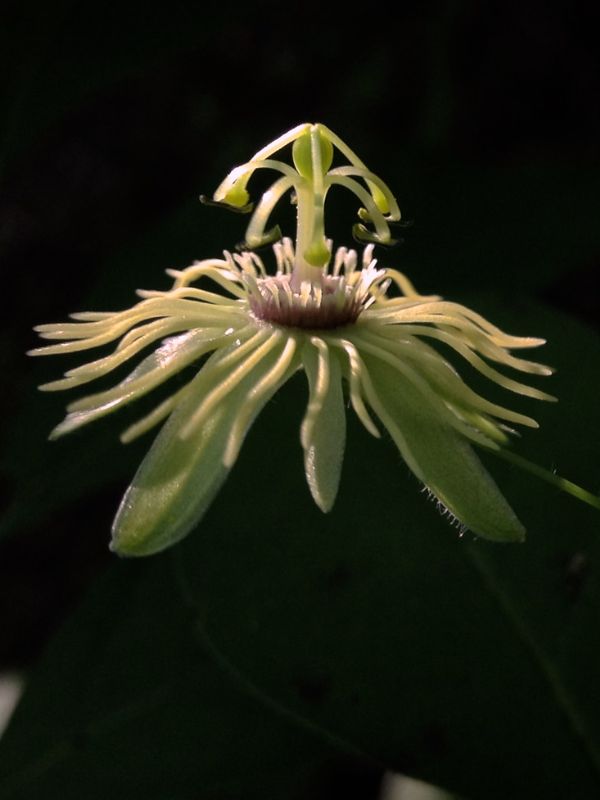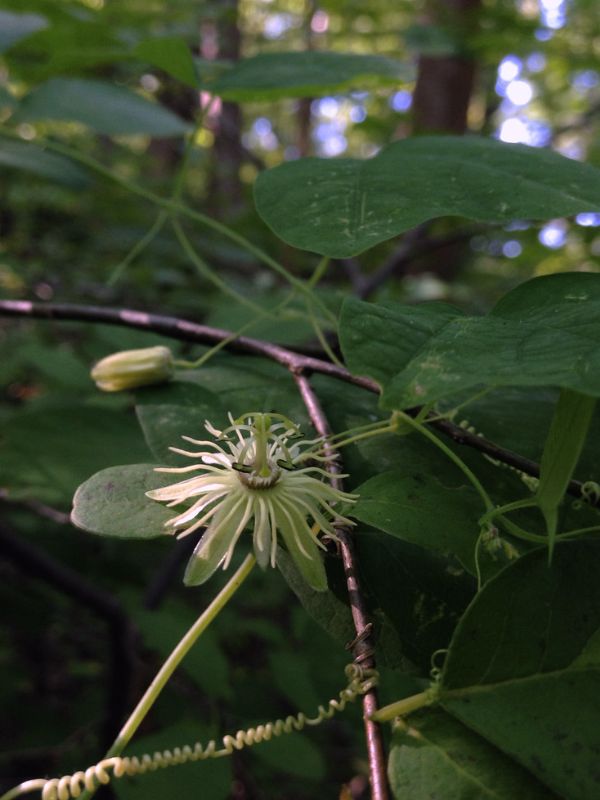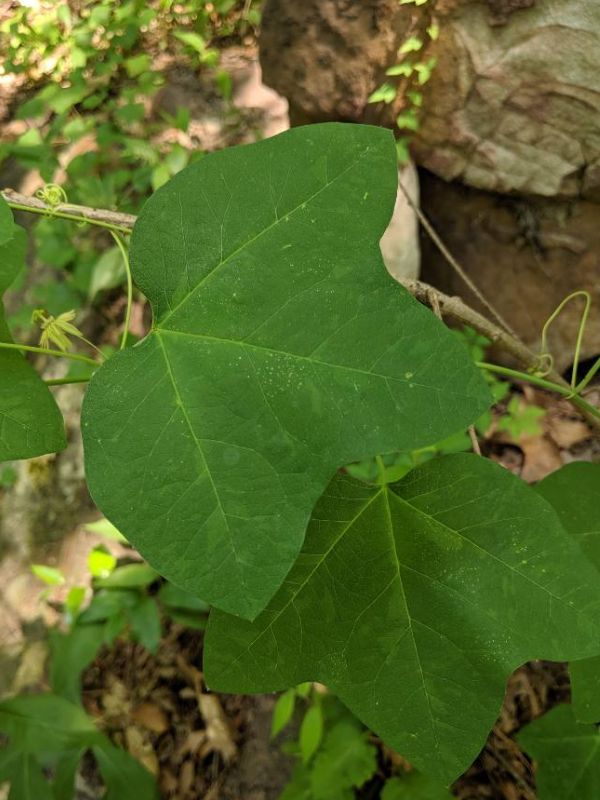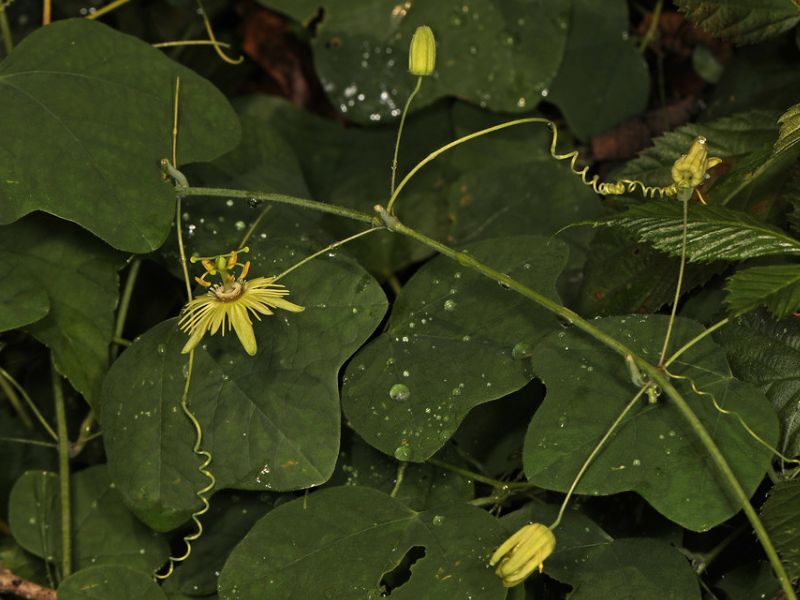Yellow Passionflower (Passiflora lutea), also known as Dwarf Passionflower, Eastern Yellow Passionflower, and Hardy Yellow Passionflower, is a perennial vine belonging to the Passifloraceae family. Native to the forests, thickets, and woodlands of eastern and south-central USA, this resilient plant thrives in a variety of natural habitats.
This vine is well-loved for its delicate, fragrant yellow flowers, which are not only visually appealing but also attract a range of pollinators, including bees and birds. It is especially valued in butterfly gardens, drawing species such as the Zebra Longwing and Gulf Fritillary, making it an excellent choice for gardeners looking to support local wildlife.
| Common name | Yellow Passion Flower, Dwarf Passionflower, Eastern Yellow Passionflower, Hardy Yellow Passionflower, Passion flower |
| Botanical name | Passiflora lutea |
| Family | Passifloraceae |
| Species | lutea |
| Origin | Eastern and south central USA |
| Life cycle | Perennial |
| Plant type | Native Plant |
| Hardiness zone | 5, 6, 7, 8, 9, 10 |
| Sunlight | Full Sun |
| Maintenance | Medium |
| Soil condition | High Organic Matter |
| Drainage | Well-Drained |
| Growth rate | Fast |
| Spacing | 12 in. – 3 ft. |
| Harvest time | Fall |
| Flowering period | Summer |
| Height | 1- 20 ft. |
| Flower color | Cream, Tan |
| Leaf color | Gray, Silver |
| Fruit color | Black |
| Fruit type | Berry |
| Flower benefit | Edible |
| Garden style | Butterfly Garden |
| Uses | Container |
I. Appearance and Characteristics
Passiflora lutea, commonly known as yellow passionflower, is a flowering perennial vine in the family Passifloraceae, native to the central and eastern United States. The vine has three-lobed leaves and small, yellowish-green, fringed flowers that appear in the summer, followed by green fruit that turn almost black at maturity. It grows in moist to wet habitats.
The genus name Passiflora comes from the Italian word “passio”, or suffering, based on an association of the flower parts to the crucifixion of Jesus Christ. The species name luteo is from the Latin word for “yellow”, due to the color of the flowers.
P. lutea is a perennial, herbaceous, climbing or trailing, unbranched vine that can reach 3–5 m (10–16 ft) in length. Curled, springlike tendrils emerging from leaf axils help the vine to climb on structures or other vegetation. The leaves are trilobed, 3–7 cm (1–3 in) long and 3–15 cm (1–6 in) broad, with a 5 cm (2 in) petiole. Leaves have smooth (entire) margins and are alternate on the stem. The upper surface of the leaves is dark green, and may be mottled with splotches of lighter green. In the north of its range, it is deciduous.
The showy flowers appear singly or in pairs on slender flower stalks up to 5 cm (2 in) long. Each flower is 1.5–2.5 cm (0.6–1.0 in) wide with narrow yellowish greenish petals and broader green sepals. The fruit is up to 1.5 cm (0.6 in) long and green, turning dark purple or black when ripe. Each fruit contains up to 10 seeds, which are brown, pointed at each end, and have a textured surface.

Yellow passionflower is often good for butterfly gardens, as it is a host for Gulf fritillaries, julia butterflies (Dryas julia), and zebra longwings (Heliconius charitonius). It is also the only pollen source used by an unusual specialist bee, Anthemurgus passiflorae, which is the sole member of its genus; this rare bee is unusual in that despite its obligate relationship with the plant (oligolecty), it rarely pollinates it.
Similar species
P. lutea is very similar to Passiflora suberosa (corkystem passionflower), differentiated by the leaves, which are more variable and generally have deeper lobes in P. suberosa, and the stems, which are corky or winged in P. suberosa. Also, P. suberosa has a more limited range, occurring in Texas and Florida and parts of Latin America. Another similar species is Menispermum canadense (Canadian moonflower), whose leaves are a different shape, with three to seven lobes instead of just three. Also, the fruit of M. canadense grows in clusters and each berry has a single crescent shaped seed.
II. How to Grow and Care
Sunlight
Yellow passionflower thrives under full sun conditions which promotes vigorous growth and optimal health. The intensity of sunlight should be direct, though yellow passionflower can tolerate partial sun, allowing some flexibility in planting location. Inadequate light may lead to reduced flowering and diminished vitality. Outdoors, yellow passionflower performs best in areas receiving unfiltered sunlight for most of the day. Its foliage might adapt to lower light by increasing leaf size to capture more sunlight. Yellow passionflower should be positioned in sunny garden spots but can withstand some shade without major detriment.
Temperature

There are many species and varieties of yellow passionflower, but most won’t handle cold very well – these should be moved inside if the temperature in your garden drops below 10 ℃ in the winter. The plant also needs regular water to thrive – it doesn’t do well in drought and requires 2.5 to 4 cm of water weekly.
Watering
Native to the southeastern United States, yellow passion flower thrives in environments that mimic its origin’s moderate humidity and consistent moisture. This species exhibits a preference for evenly moist soil conditions without being waterlogged. Watering every week is ideal to maintain its hydration balance. Yellow passionflower is more commonly grown outdoors due to its need for natural climatic conditions, where it can exhibit its deciduous nature by shedding leaves in response to water stress or seasonal changes.
Soil
Yellow passionflower is not fussy about soil type, but requires constant moisture and good drainage, which can be difficult to achieve. You can always mix the soil with organic compost, which will improve drainage and regulate moisture. The plant thrives in slightly acidic soil, with an ideal pH ranging from 5.0-6.0.
Fertilizing

For yellow passionflower, use balanced nutrition fertilizers to enhance growth, flowering, and vigor. Apply a quarter-strength liquid fertilizer biweekly during active growth in spring and summer, tapering off in fall and winter. Avoid over-fertilization to prevent root damage. Variances in seasonal growth stages necessitate adjustments in fertilization frequency and quantity. Water yellow passionflower thoroughly before and after fertilizing to ensure even nutrient distribution and root absorption.
Planting Instructions
Yellow passionflower can easily be planted as a small plant, but can also be grown from seed. This can sometimes take more than a month, and you will need to wait until seedlings have developed a couple of sets of leaves before transplanting them. Planting is best done in the spring or fall, when the soil is still warm. Choose a sunny site in your garden with shelter from strong winds and water well after planting.
Pruning
Yellow passionflower is a vine that doesn’t necessarily require pruning to grow, but this will result in a fuller plant. Pruning is best performed in late winter or early spring. The flowers don’t need to be deadheaded – simply remove any dead plant parts and trim to enhance shape. Use clean and sharp pruners and always disinfect your tools to avoid any possible spread of diseases.
Propagation

To propagate your yellow passionflower, take a cutting that’s 10 to 15 cm long. Remove the bottom leaves, dip into rooting hormone, and place into a pot with moist soil. Cover with plastic and keep shaded, warm, and moist, repotting once a root system has developed. This usually takes about a month.
Transplanting
Ideally, transplanting yellow passionflower is best executed in spring, or ‘S1’, as its roots establish faster during this rejuvenating period. Yellow passionflower favors partial sun or full shade locations. Tip: retain sufficient soil around the roots to prevent shock and ensure successful transplanting.
III. Uses and Benefits
Yellow passionflower is an easy-to-grow climbing vine that does not damage structures. The vine clings to walls, fences, and trellises using soft tendrils. The hardy vine grows in a variety of soil types, as long as there is drainage. The warm weather bloomer is used in cottage and Mediterranean gardens. It also makes a good container plant.
IV. Harvesting and Storage

The flowers from your yellow passionflower can be snipped off individually and used either fresh or dried in the kitchen. The fruit is usually ready in the late summer to early fall, and should be picked when they are plump and have a deep orange, red, or purple color, depending on the variety you are growing.
Find Where to Buy the Best Yellow Passion Flower (Passiflora lutea)


















Leave a Reply